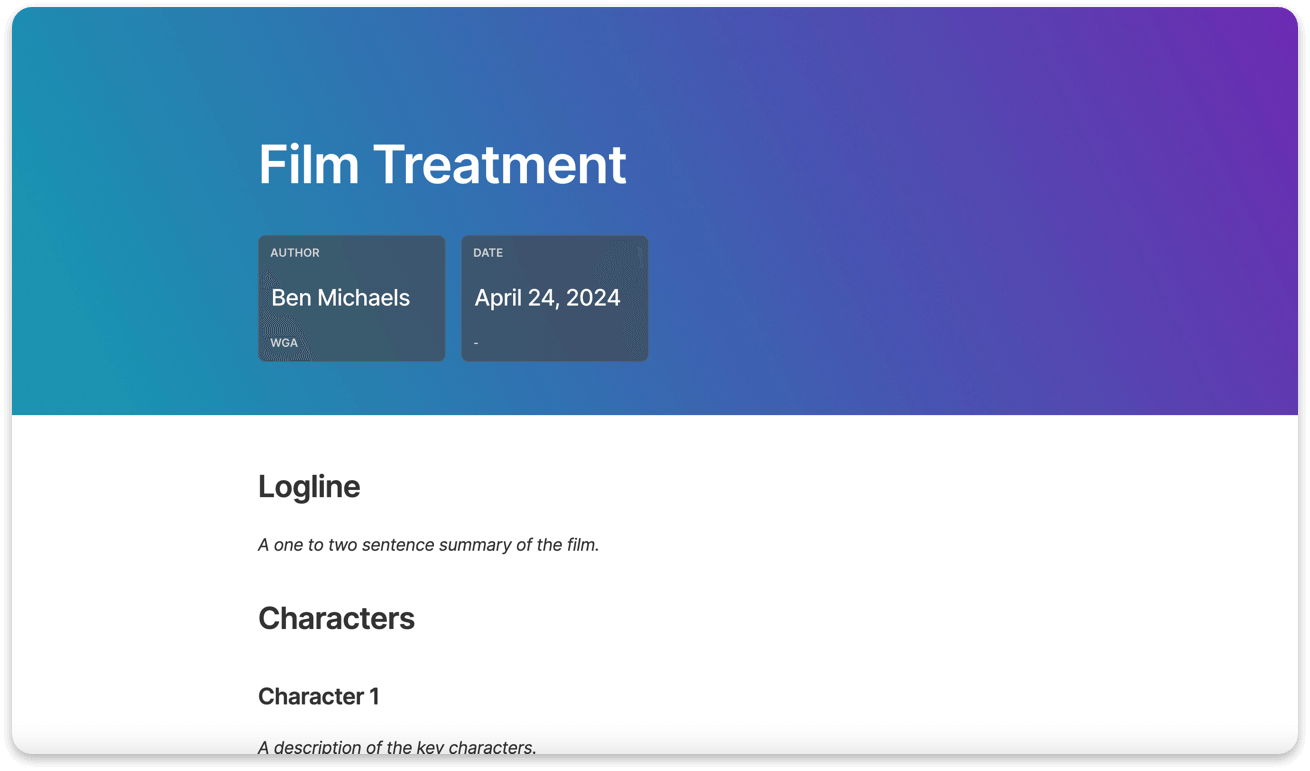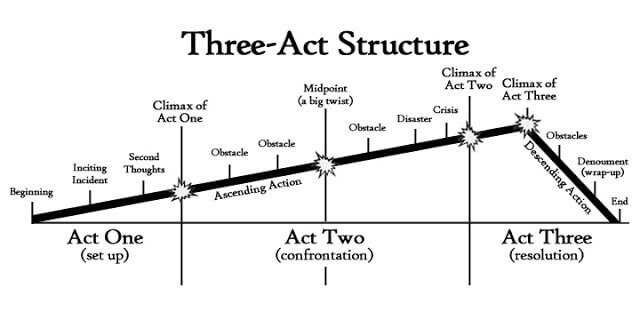Bringing a movie or TV show to life starts with an idea. However, jumping from an idea to a fully developed script involves many steps in between. One of these steps includes structuring the idea into a cohesive narrative by writing a treatment. A film treatment is the first stepping stone to writing a full screenplay and vital when pitching the idea to studios, production companies, or investors.
What is a Film Treatment?
A film treatment is an in-depth summary of an idea for a film, including the story, concept, characters, and other important creative details. Treatments are a staple in all types of creative projects, including movies, commercials, novels, TV shows, documentaries, and more. No matter what creative project you are developing, writing a treatment can help organize your thoughts.
To help streamline this part of the development process, Assemble has created a film treatment template that you can use below. Using this fully customizable template, you can format your ideas while learning how to write a film treatment. This cloud-based document enables you to collaborate with others and easily share it for presentation.

Film Treatment Template
Use our film treatment template to summarize your project in a professional format for studios, investors and talent.
Get TemplateWho Writes the Film Treatment?
Typically, screenwriters write the film treatment before they start writing the screenplay. However, it is also common for producers or directors to write treatments for ideas they wish to develop into a bigger project. As a general rule of thumb, the person with the initial story idea is the best person to write the treatment. You don’t need specialized screenwriting software to write a film script treatment.
Why Should I Write a Film Treatment?
For screenwriters, a film treatment is the best way to develop the film's narrative structure and character development. Writing a script is a long and challenging process, which becomes more difficult if you have to stop halfway through to address plot holes. Writing a treatment beforehand makes writing the screenplay much easier as it is a step-by-step guideline on how the action unfolds. It is also a great collaboration tool, allowing producers or directors to give their input early in the development process. Rewriting a treatment is much quicker than rewriting a script.
As mentioned above, producers or directors will also write treatments if they have a story idea they wish to develop. Then, they will share these treatments with a screenwriter who will expand it into a full-fledged movie or TV show.
Apart from helping develop the film itself, treatments can be vital for pitching and securing financing. Reading screenplays requires a significant time commitment, which film executives rarely have. Therefore, many producers, agents, or executives would much rather read a short but detailed treatment. It is a great way to gauge someone’s interest in the project before you commit to writing a screenplay. Additionally, most screenwriting grants or competitions also require a completed treatment as part of their application process.
What is the Format of a Film Treatment?
The film treatment structure is straightforward, with five key sections: project information, logline, characters, synopsis, and three act structure. Let’s take a look at each of these sections in greater detail.
Project Information
At the top of the document, include the project's title, date of the treatment, author, and contact details.
Logline
The logline is a brief one to two sentence summary of the film. A logline aims to hook the reader and pique their curiosity. When writing a logline, highlight the central conflict underpinning the story. You can also include the themes, genre, and character. Loglines are vital for pitching a film, and if you are having trouble writing a logline, try using a logline generator.
Characters
List every major character that will be present in the story. A major character is any character required for the film’s story to progress. All the major characters should have some type of character arc that a reader can follow from start to finish. Furthermore, this section should describe their appearance, personality, and relationship with other characters. Aim to establish their character traits and hint at how we will see their character develop over the course of the movie or TV show.
Synopsis
Imagine the synopsis as a bird's eye view of the film’s storyline. When writing the synopsis, focus primarily on the plot and how the main characters will push it forward. Ensure that it summarizes the story including any critical moments of conflict between characters. The synopsis should include descriptions of all the major plot points, inciting incidents, and climactic moments. However, ensure the synopsis isn’t too long and hard to read. An ideal film synopsis should take around two or three minutes to read, with enough detail to keep the reader excited but not overwhelmed.
Three Act Structure
Finally, the last section of a treatment is an outline of the story that follows the three act structure. For this section, provide an overview of each act and highlight the key plot points as the story develops. Sometimes, this section can be combined with the synopsis for a more detailed description of the film’s narrative.
Act 1: Known as the ‘Set Up’. This act introduces the audience to the characters and world and ends with the first major plot point that kicks off the storyline, typically called the ‘inciting incident’.
Act 2: Known as the ‘Confrontation’. The story's action, tension, or stakes must keep rising in this act. At the midpoint of the film, a second major plot point occurs. Usually, the end of the second act features a pre-climax moment, which sets up the upcoming final act of the film.
Act 3: Known as the ‘Resolution’. This act begins with the climax the film has been building up towards since the first act. In a traditional action movie, the climax is when the protagonist overcomes their obstacles and defeats the antagonist. The finale is followed by a resolution period, marked by descending action as the film transitions to the epilogue.

Additional Tips for Writing a Treatment
When writing a treatment, here are some simple formatting rules to keep in mind:
- Write in the present tense. Describe the action as it develops in the story.
- Write in prose format from a third-person perspective. A good treatment outlines the story and tone from a general perspective. Try to avoid writing dialogue lines.
- Remember to keep it simple. The goal is to convey the story to an average reader rather than a literary expert.
With that being said, here is an important caveat. When writing a treatment, keep the audience in mind.
If you are writing the treatment as a tool to develop the script, then the rules don’t necessarily apply. Even the biggest directors in the film industry break the rules mentioned above. Most famously, James Cameron is known for writing extremely detailed film treatments, mapping out every story beat from start to finish. If you’re writing the treatment for yourself, the screenplay treatment can be as long and detailed as necessary.
However, remember the formatting rules mentioned above if you intend to use the treatment to pitch producers or executives. A fifty page document detailing every minor plot detail and character interaction may scare away potential investors.
Summary
This article should give you everything you need to begin writing your first film treatment. When writing, always keep the audience in mind, as it will significantly affect the scope and length of the treatment. If you’re interested in writing a treatment for a television commercial, check out Assemble’s guide on how to write a winning director’s treatment.

